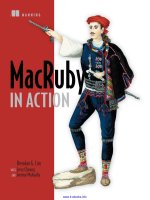Kanban in action
Bạn đang xem bản rút gọn của tài liệu. Xem và tải ngay bản đầy đủ của tài liệu tại đây (35.76 MB, 361 trang )
MANNING
Marcus Hammarberg
Joakim Sundén
FOREWORD BY
Jim Benson
www.it-ebooks.info
Kanban in Action
www.it-ebooks.info
Download from Wow! eBook <www.wowebook.com>
www.it-ebooks.info
Download from Wow! eBook <www.wowebook.com>
Kanban in Action
MARCUS HAMMARBERG
JOAKIM SUNDÉN
MANNING
SHELTER ISLAND
www.it-ebooks.info
Download from Wow! eBook <www.wowebook.com>
For online information and ordering of this and other Manning books, please visit
www.manning.com. The publisher offers discounts on this book when ordered in quantity.
For more information, please contact
Special Sales Department
Manning Publications Co.
20 Baldwin Road
PO Box 261
Shelter Island, NY 11964
Email:
©2014 by Manning Publications Co. All rights reserved.
No part of this publication may be reproduced, stored in a retrieval system, or transmitted, in
any form or by means electronic, mechanical, photocopying, or otherwise, without prior written
permission of the publisher.
Many of the designations used by manufacturers and sellers to distinguish their products are
claimed as trademarks. Where those designations appear in the book, and Manning
Publications was aware of a trademark claim, the designations have been printed in initial caps
or all caps.
Recognizing the importance of preserving what has been written, it is Manning’s policy to have
the books we publish printed on acid-free paper, and we exert our best efforts to that end.
Recognizing also our responsibility to conserve the resources of our planet, Manning books are
printed on paper that is at least 15 percent recycled and processed without elemental chlorine.
Manning Publications Co.
20 Baldwin Road
PO Box 261
Shelter Island, NY 11964
Development editors:
Copyeditor:
Proofreader:
Typesetter:
Cover designer:
Beth Lexleigh, Cynthia Kane
Melinda Rankin
Tiffany Taylor
Marija Tudor
Marija Tudor
ISBN: 9781617291050
Printed in the United States of America
1 2 3 4 5 6 7 8 9 10 – MAL – 19 18 17 16 15 14
www.it-ebooks.info
Download from Wow! eBook <www.wowebook.com>
brief contents
PART 1
LEARNING KANBAN ...................................................... 1
1
PART 2
PART 3
■
Team Kanbaneros gets started 3
UNDERSTANDING KANBAN ......................................... 45
2
■
3
■
4
■
5
■
6
■
7
■
Kanban principles 47
Visualizing your work 56
Work items 70
Work in process 92
Limiting work in process 109
Managing flow 130
ADVANCED KANBAN . ................................................ 165
8
■
9
■
10
■
11
■
12
■
13
■
Classes of service 167
Planning and estimating 185
Process improvement 216
Using metrics to guide improvements 237
Kanban pitfalls 270
Teaching kanban through games 286
v
www.it-ebooks.info
Download from Wow! eBook <www.wowebook.com>
vi
BRIEF CONTENTS
www.it-ebooks.info
Download from Wow! eBook <www.wowebook.com>
contents
foreword xiii
preface xvii
about this book xix
about the authors xxiii
about the cover illustration
acknowledgments xxvi
PART1
xxv
LEARNING KANBAN .......................................... 1
1
Team Kanbaneros gets started 3
1.1
1.2
1.3
1.4
1.5
1.6
1.7
1.8
1.9
1.10
Introductions 5
The board 8
Mapping the workflow
Work items 18
Pass the Pennies 22
Work in process 27
Expedite items 35
Metrics 38
The sendoff 41
Summary 42
12
vii
www.it-ebooks.info
Download from Wow! eBook <www.wowebook.com>
viii
CONTENTS
PART 2
UNDERSTANDING KANBAN .............................. 45
2
Kanban principles 47
3
Visualizing your work 56
2.1
2.2
2.3
3.1
The principles of kanban 49
Get started right away 53
Summary 55
Making policies explicit
58
Information radiator 59
3.2
The kanban board
The board 63
the board 66
3.3
3.4
4
■
63
Mapping your workflow to
Queues 67
Summary 69
Work items 70
4.1
Design principles for creating your cards
Facilitate decision making
outcomes 73
4.2
Work-item cards
72
72
Help team members optimize
■
75
Work-item description 75 Avatars 78
Tracking IDs 80 Blockers 81
■
■
Deadlines
79
■
4.3
4.4
4.5
4.6
Types of work 83
Progress indicators 85
Work-item size 86
Gathering workflow data
Gathering workflow metrics
emotions 89
4.7
4.8
5
87
87
■
Gathering
Creating your own work-item cards
Summary 90
90
Work in process 92
5.1
Understanding work in process
What is work in process? 93
software development? 96
■
93
What is work in process for
www.it-ebooks.info
Download from Wow! eBook <www.wowebook.com>
ix
CONTENTS
5.2
Effects of too much WIP 99
Context switching 99 Delay causes extra work 101
Increased risk 103 More overhead 104
Lower quality 105 Decreased motivation 106
■
■
■
5.3
6
Summary 107
Limiting work in process 109
6.1
The search for WIP limits
110
Lower is better than higher 110
No limits is not the answer 111
6.2
Principles for setting limits
Stop starting, start finishing
answer 113
6.3
■
People idle or work idle
111
112
112
One is not the
■
Whole board, whole team approach
115
Take one! Take two! 115 Come together 116 Drop down
and give me 20 117 Pick a number, and dance 118
■
■
■
6.4
Limiting WIP based on columns 119
Start from the bottleneck 119 Pick a column that will help you
improve 120 A limited story, please 120 How to
visualize WIP limits 122
■
■
6.5
■
Limiting WIP based on people
123
Common ways to limit WIP per person 123
6.6
Frequently asked questions
126
Work items or tasks—what are you limiting?
count queues against the WIP limit? 127
6.7
6.8
7
Should you
130
Why flow? 132
Eliminating waste 132
development 133
7.2
■
Exercise: WIP it, WIP it real good 128
Summary 128
Managing flow
7.1
126
■
Helping the work to flow
The seven wastes of software
134
Limiting work in process 134 Reducing waiting time 135
Removing blockers 137 Avoiding rework 140
Cross-functional teams 141 SLA or lead-time target 143
■
■
■
www.it-ebooks.info
Download from Wow! eBook <www.wowebook.com>
x
CONTENTS
7.3
Daily standup 143
Common good practices around standups 144 Kanban
practices around daily standups 146 Get the most out of your
standup 148 Scaling standups 151
■
■
■
7.4
7.5
What should I be doing next?
Managing bottlenecks 158
154
Theory of Constraints: a brief introduction
7.6
PART 3
8
159
Summary 163
ADVANCED KANBAN ...................................... 165
Classes of service 167
8.1
8.2
The urgent case 168
What is a class of service? 170
Aspects to consider when creating a class of service 170
Common classes of service 171 Putting classes of services
to use 177
■
8.3
8.4
8.5
9
Managing classes of services
Exercise: classify this! 184
Summary 184
181
Planning and estimating 185
9.1
Planning scheduling: when should you plan? 187
Just-in-time planning 188 Order point 189 Priority
filter: visualizing what’s important 191 Disneyland wait
times 194
■
■
■
9.2
Estimating work—relatively speaking
Story points 197
9.3
■
9.4
9.5
T-shirt sizes 199
Estimation techniques
A line of cards 202
Goldilocks 206
196
■
201
Planning Poker 203
Cadence 208
Planning the kanban way: less pain, more gain 210
The need diminishes 211 Reasoning logically: the customer’s
plea 212 #NoEstimates—could you do without this
altogether? 213
■
■
9.6
Summary 215
www.it-ebooks.info
Download from Wow! eBook <www.wowebook.com>
xi
CONTENTS
10
Process improvement 216
10.1
Retrospectives 218
What is a retrospective? 218
10.2
■
How does it work?
219
■
What happened 234
Root-cause analysis 222
How it works 223
10.3
Kanban Kata 228
What is Kanban Kata? 229
Why does this work? 234
10.4
11
Summary 236
Using metrics to guide improvements 237
11.1
Common metrics 238
Cycle and lead times 238 Throughput 243 Issues and
blocked work items 245 Due-date performance 247
Quality 249 Value demand and failure demand 251
Abandoned and discarded ideas 252
■
■
■
■
11.2
Two powerful visualizations 254
Statistical process control (SPC) 254
diagram (CFD) 260
11.3
11.4
11.5
12
Metrics as improvement guides
Exercise: measure up! 269
Summary 269
■
Cumulative flow
264
Kanban pitfalls 270
12.1
All work and no play makes Jack a dull boy
271
Creating cadences for celebration 274
12.2
12.3
12.4
12.5
13
Timeboxing is good for you 275
The necessary revolution 279
Don’t allow kanban to become an excuse to be lazy
Summary 285
Teaching kanban through games 286
13.1
Pass the Pennies 288
What you need to play the game 288 How to play 288
Questions for discussion 290 Main take-aways 291
Tips and variants 291
■
■
www.it-ebooks.info
Download from Wow! eBook <www.wowebook.com>
281
xii
CONTENTS
13.2
The Number Multitasking Game
291
What you need to play the game 292 How to play 292
Questions for discussion 294 Main take-aways 294
■
■
13.3
The Dot Game 295
What you need to play the game 295 How to play 296
First iteration 297 Second iteration 299 Third (and
final) iteration 300 Main take-aways 301
Tips and variants 302
■
■
■
■
13.4
The Bottleneck Game 302
What you need to play the game 303 How to play 303
Questions for discussion 304 Main take-aways 304
■
■
13.5
getKanban
304
What you need to play the game 305 How the game is
played 305 Questions for discussion 306 Tips and
variants 306 Main take-aways 306
■
■
■
■
13.6
The Kanban Pizza Game 307
What you need to play the game 307 How to play 307
Questions for discussion 308 Main take-aways 308
■
■
13.7
appendix A
appendix B
Summary 309
Recommended reading and other resources
Kanban tools 316
index
311
323
www.it-ebooks.info
Download from Wow! eBook <www.wowebook.com>
foreword
A great deal of your brain’s capacity is devoted to absorbing, processing, acting on,
and storing visual information. What we see inspires us to act now and instills patterns
for future action. If we have nothing to look at, we have little to act on.
See and understand
Visual systems like kanban draw their power from our preference for visual information. Take a look, for example, at the following simple map. You see the water, the
buildings, the roads, and a host of other information. You recognize this immediately.
Within the blink of an eye, you understand context, form, and substance.
xiii
www.it-ebooks.info
Download from Wow! eBook <www.wowebook.com>
xiv
FOREWORD
Here is a list of everything I cared to write down from that map. This is a partial list.
And it’s in a font size necessary not to fill pages with text:
■
■
■
■
■
■
■
■
■
■
■
■
Salmon Bay Marine Center
Lake Washington Ship Canal
W. Commodore Way
20th Ave W
Gilman Place W
W Elmore Street
21st Ave W
Gilman Ave W
Shilshole Ave NW
W Fort Street
26th Ave W
24th Ave W
You can quickly see that long lists of things provide less context and take more time to
process than a map.
Our goal with visual systems like kanban is to build a map of our work. We want the
form and substance of our work. We want to understand the system, immediately and
intuitively. We want our kanban board to be explicit about roles, responsibilities, work
in progress, rate of completion, the structure of our processes, impediments, and more.
That’s a lot of information.
What we’ve found since launching kanban as a software design tool nearly a
decade ago is this:
Seeing the work and the process creates understanding.
Once we see our work, we build a shared understanding of it. Then we can do away
with messy process conventions that have plagued software development for years.
The kanban board can become a simple single point that lets anyone come and
understand the current state of the project.
This means software teams can finally speak the same language as the business!
The division between IT and the rest of the company can dissolve. A translator has
arrived.
Seeing is half the battle
In this book, Marcus and Joakim list three elements of a project using kanban:
■
■
■
Visualize
Limit work in process
Manage flow
I like this list.
www.it-ebooks.info
Download from Wow! eBook <www.wowebook.com>
FOREWORD
xv
For Personal Kanban, we use the first two (visualize your work and limit work in process) and see the third as following naturally. But I like the list of three because it
drives this point home:
Work does not fit—it flows.
Smashing work into arbitrary amounts of time has profound negative impacts on rate
of completion, escaped defects, and morale. The stress of unnecessary deadlines or
overenthusiastic feature sets deprecates both people and product. The focus becomes
making work fit into the deadline period, rather than completion with quality.
Completion of work with quality is possible only if work is flowing at a truly sustainable pace. Finding and maintaining that pace is possible only if active work in process
(WIP) is less than the capacity of those doing the work. Cramming things in before
deadlines will almost always result in breaking your WIP limit.
Too much WIP destroys flow
With a reasonable WIP limit, we encourage the flow of work. Tasks are completed in a
measured fashion with an eye on quality. Overhead from managing too much WIP disappears. And, not surprisingly, productivity skyrockets.
This is the short form of what Marcus and Joakim have given you in this book.
They provide fantastic and patient detail. If this is your entrée into kanban, welcome.
You couldn’t have asked for better guides.
JIM BENSON
AUTHOR OF THE 2013 SHINGO AWARD-WINNING
PERSONAL KANBAN
www.it-ebooks.info
Download from Wow! eBook <www.wowebook.com>
xvi
FOREWORD
www.it-ebooks.info
Download from Wow! eBook <www.wowebook.com>
preface
Marcus’s journey
I was introduced to agile via Scrum and started to use it, guerilla-style, at a large insurance company in Sweden. Before long, it spread; and within a few years the company
had more than 50 Scrum teams. But it still didn’t feel right, because the work processes
for many teams weren’t a good fit with the start-stop nature of Scrum. Also, most teams
didn’t span the entire process; the teams mostly consisted of developers who were
handed requirements and who then delivered to a separate testing phase. I felt the itch
to try to incorporate more of the complete process that the work went through.
This itch led me to start investigating other practices in the agile community.
Before long, and through some helpful pointers from Joakim, I found and started to
read up on kanban. In 2010 and 2011, I attended trainings on kanban and kanban
coaching given by David J. Anderson. These further confirmed my feeling that kanban and Lean were what I had been looking for.
Joakim’s journey
In 2008, I was consulting as a Scrum Master in a three-team software development
project in a large Swedish company’s IT department. To deepen my understanding of
agile software development, I was reading up on Lean software development—which
led me to the amazing story of Toyota and a lot of literature about Lean thinking and
the Toyota Way. The studying reached a climax of sorts when I went on a study tour to
Toyota HQ in Japan together with Mary and Tom Poppendieck, authors of Lean software development books, in the spring of 2009.
xvii
www.it-ebooks.info
Download from Wow! eBook <www.wowebook.com>
xviii
PREFACE
In late 2008, my client came to the conclusion that most, if not all, clients paying
for software development eventually draw—that things are moving too slowly. They
wanted more development done more quickly, but without cutting scope or quality.
Inspired by the Lean thinking around one-piece contiguous flow, I suggested that we
should stop planning batches of work in Scrum sprint-planning meetings every two or
three weeks (a cadence that felt more and more arbitrary to us) and instead try to
focus on one or a few work items and collaboratively get them done as quickly as possible, in a continuous flow of value. The dozen or so team members agreed to not
have more than two work items in development and two in testing at any time, and
that only when something was finished would we pull new work items from the backlog to plan them just-in-time.
I soon learned about something called kanban that seemed similar to what we
were doing, first through Corey Ladas’s blog and then through the work of David J.
Anderson. In 2009, I connected with the community through the first Lean Kanban
conference in the UK. I was immediately attracted by the pragmatic approach of looking at what had actually worked for different teams and companies in their respective
contexts, at a time when I felt that a lot of the agile community focus was on faithbased approaches like “How is Scrum telling us how to solve this?”
The next year, I participated in David J. Anderson’s first kanban coaching workshop ever (now called Advanced Master Class) in London, together with, among others, experienced practitioners like Rachel Davies, David P. Joyce, and Martine Devos. I
cofounded Stockholm Lean Coffee in 2010, where kanban enthusiasts have kept
meeting every week since. In 2011, I was invited to attend the first Kanban Leadership
Retreat hosted by David J. Anderson, during which I became one of the first “David J.
Anderson approved” kanban trainers.
The common journey
Together with our colleague at Avega Group at the time, Christophe Achouiantz, we
started developing a practical introduction to kanban in 2010. It was an immediate
success and the starting point for a long series of conference talks in both Europe and
the US, including in-client trainings, tutorials, and workshops, sometimes conducted
individually, sometimes by the two of us together. The practical approach of our work
resonated well with many people who attended our talks and tutorials, and we
received a lot of positive feedback.
It was after a conference tutorial at JFokus (a great conference organized by Mattias Karlsson, another Avega Group colleague) that Marcus got a call from Manning
Publications, asking him if he was interested in writing a book. He immediately felt
that he should do it together with Joakim. We decided to write the book in the same
manner as the presentation we had created, using a practical approach and a lighthearted style.
www.it-ebooks.info
Download from Wow! eBook <www.wowebook.com>
about this book
Do you want to better understand how your work works and what is happening on
your team or in your workplace? Would you benefit from being able to focus on a few
small things instead of constantly having to switch between multiple projects? Do your
users and stakeholders want new features delivered now rather than some other day?
Do you think that you and your coworkers need to keep improving and learning?
Then kanban is for you.
Do you want to get started with kanban as soon as possible, without spending too
much time on abstract theory and history and splitting hairs about different methods?
Do you want to know how people in the kanban community have used kanban in practice to face different challenges?
Then this book is for you.
This book is a down-to-earth, no-frills, get-to-know-the-ropes introduction to kanban. It’s based on lots of practice, many observations, and some hearsay (!) from two
guys who have worked with and coached dozens of kanban teams. We’ve also talked
and taught at conferences and actively participated in user groups and the kanban
community over the last few years.
In this book, you’ll read about simple but powerful techniques to visualize work:
how to design a kanban board, how to track work and its progress, how to visualize
queues and buffers, and even such nitty-gritty details as how colors and other
enhancements can help you to organize and track your work items.
You’ll also pick up a lot of practical advice about how to limit your work in process
throughout the workflow, such as how to set the limit in different ways depending on
context, and how to understand when and how to change it.
xix
www.it-ebooks.info
Download from Wow! eBook <www.wowebook.com>
xx
ABOUT THIS BOOK
With these two tools in hand—kanban and this book—you’re ready to get down to
business and help your work flow through the system as you learn and improve your process further and further. You’ll learn about things like classes of service, how planning
and estimation are done in kanbanland, about queues and buffers and how to handle
them, and—well, you’ll learn a lot of things that you’ll need to help your team
become a little better every day.
But wait, there’s more. You’ll learn about metrics and how to use them to improve,
and we’ll present several games and exercises you can use to understand the principles of kanban and get new people to join you on the kanban bus. Hey, we even throw
in a small section on kanban pitfalls and common criticisms, just for good measure.
This is a practical book, and we won’t spend a lot of time on the underlying theory
or the history behind kanban. There are already great books on these topics (hint:
pick up some books about Lean, agile, and Toyota), and they do a much better job at
that than we could ever dream of doing. But we won’t leave you high and dry; some
theory will be needed to make good use of the practical advice we’re giving, and we’ll
supply it to you.
But this book is not only for beginners. Judging from all the questions we receive
about kanban, and from all the light bulbs that get turned on during our practically
oriented talks and training courses for people who have been working with kanban
for some time, as well as for novices, you’ll get a lot out of this book even if you’re far
from new to kanban.
Let’s get started and see some kanban in action!
The structure of this book
This book is divided into four parts, each with a different purpose, aimed at being
your companion as you learn kanban:
■
■
Part 1, “Learning kanban”—This is an introduction to kanban in the form of a
short story. The idea is that you can quickly skim through this part to get a feeling for what kanban is and learn enough about it to get you up and running,
just like the fictional team you’ll meet in chapter 1. After this introduction,
you’ll have all the tools and knowledge you need to start using kanban in real
life—you’ll be able to start learning by doing kanban. If stories aren’t your
thing, or if you don’t like our storytelling style, you can skip this chapter and
jump straight into the next part.
Part 2, “Understanding kanban”—This part gives you deeper knowledge about
the why (the principles and ideas behind kanban) and the how (lots of practical
tips on applying the principles in your context). We’ll take a closer look at the
core principles of kanban. There will be many commonly used solutions and
variations on these, which people in the community have applied in different
contexts. Our descriptions will be practical and will give you more tools and tips
to continue to build your knowledge. The team from chapter 1 will pop in from
time to time to ask questions.
www.it-ebooks.info
Download from Wow! eBook <www.wowebook.com>
ABOUT THIS BOOK
■
■
xxi
Part 3, “Advanced kanban”—OK, you’re up and running with your board, you’re
familiar with how WIP limits work, and you’re focused on helping the work to
flow. Now what? In chapters 8–12, you’ll learn how to use kanban principles to
manage risk, facilitate self-organization, plan, and improve. We’ve also included
a chapter on common pitfalls and how to avoid them. Don’t let the “advanced”
scare you: it’s not that complicated, it’s just that these practices aren’t what you
start with typically when you’re new to kanban.
Part 4, “Teaching kanban”—If you start using kanban in your organization, you’ll
soon find yourself teaching kanban to others. We have found it beneficial to do
this through games and simulations, because some of the principles seem counterintuitive at first.
We make no claim that you’ll come out a kanban master at the end of this book, but it
will make a good companion on your learning journey. Matched with the practical
experience you’ll gain from trying stuff out, this will be a great learning combination.
How to read this book
You can choose several ways to read this book:
■
■
■
■
■
If you want to get started as fast as possible, spend an hour reading part 1 (“Learning kanban”), and implement some of the things you learn right away.
When you need inspiration or get stuck, browse through part 2 (“Understanding
kanban”) and steal ideas or be inspired by how others have approached similar
challenges.
If you want to know why things are how they are in kanban-land, read part 2 and learn
where kanban comes from and the principles and ideas on which it’s based.
You’ll get a hefty dose of practical tips along the way.
If you’re already using kanban and are curious about the next step, take a closer look at
the topics in part 3 (“Advanced kanban”). You’ll be sure to pick up something
new that applies to your situation.
When people ask you to teach them kanban, find fun and educational games in part 4
(“Teaching kanban”) to play with them, and tell them about your findings and
experiences. And then get them a copy of this book!
You can also read the entire book from cover to cover. This will give you a gradually
deeper and wider understanding of kanban. We believe that the best learning experience will come from combining the topics in this book with practical experience.
Author Online
Purchase of Kanban in Action includes free access to a private web forum run by Manning Publications where you can make comments about the book, ask technical
questions, and receive help from the authors and from other users. To access the forum
and subscribe to it, go to www.manning.com/KanbaninAction. This page provides
www.it-ebooks.info
Download from Wow! eBook <www.wowebook.com>
xxii
ABOUT THIS BOOK
information on how to get on the forum once you’re registered, what kind of help is
available, and the rules of conduct on the forum.
Manning’s commitment to our readers is to provide a venue where a meaningful
dialog between individual readers and between readers and the authors can take
place. It’s not a commitment to any specific amount of participation on the part of the
authors, whose contribution to the forum remains voluntary (and unpaid). We suggest you try asking the authors some challenging questions lest their interest stray!
The Author Online forum and the archives of previous discussions will be accessible from the publisher’s website as long as the book is in print.
www.it-ebooks.info
Download from Wow! eBook <www.wowebook.com>
about the authors
Before we set out on this journey together, it might be interesting for you to get to
know us a bit. Here we are—plain and simple:
JOAKIM is a thinker, the brains in our dynamic duo. He often lets
a person talk for quite a while before he makes up his mind what to
say, and then he responds with something profound meant to make
them think. This annoys some people, because they usually just
want to know what “to do.” He has solid theoretical knowledge in all
things Lean, agile, and about the Toyota Production System. And
he has a lot of practical experience to go along with it, too.
In his spare time, Joakim is a foodie and a movie buff, and quotes from obscure
Danish dogma movies sneak into his conversations from time to time (much to the
confusion of those around him).
Joakim has four kids (ages zero to nine) and a wife (Anna) and still manages to be
engaged in the progress of the company he works for (Spotify) and the Lean and agile
communities in Sweden and around the world. He’s a regular speaker at international
conferences.
MARCUS is a doer and thus the muscle of the pair, to continue
with the “dynamic duo” metaphor. He prefers to try something out
and fail rather than think about doing it right the first time. This
leads to him having do stuff over and over again—much to his irritation and the amusement of others.
Marcus has approached the Lean and kanban communities
from a developer’s perspective and has a strong interest in the
xxiii
www.it-ebooks.info
Download from Wow! eBook <www.wowebook.com>
xxiv
ABOUT THE AUTHORS
practices that make these ideas work in the wild: test-driven development, pair programming, specification by example, and impact mapping, among others.
When he has time, he can be found blogging or at the Salvation Army or reading
up on the latest brass-band news. Trying to incorporate much of that into work-related
situations is both hard and pretty much useless, as you can probably imagine.
Marcus is married to Elin, and they have three boys (5, 3, and 3 years old1). By the
time you read this, they will all have moved to Indonesia, where Marcus will work for the
Salvation Army. He will lead the work at a foundation, for the Salvation Army’s 6 hospitals and 13 clinics in Indonesia. This will, of course, be done in an agile, Lean fashion,
drawing inspiration from and using the techniques found in this book. Marcus will also
teach brass instruments to the youngsters at the Salvation Army orphanages.
1
Yes, the last two are twins.
www.it-ebooks.info
Download from Wow! eBook <www.wowebook.com>









